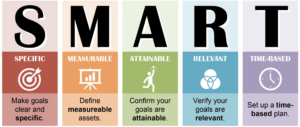What are SMART Goals?
SMART goals are statements that outline the essential results you aim to achieve. They are crafted to ensure clear and mutual understanding of expected performance levels and professional development. The SMART criteria stand for Specific, Measurable, Achievable, Relevant, and Time-Bound. Setting goals is an integral part of personal and professional growth. However, it’s not just about stating your objectives; it’s about creating goals that are specific, measurable, achievable, relevant, and time-bound—SMART goals. In this guide, we’ll explore what SMART goals are, understand the criteria behind them, and provide a step-by-step guide on how to craft effective SMART goals.

Specific:
Define what will be accomplished.
Identify the necessary actions, including who, what, when, where, which, and why.
Focus on end results, not just tasks.
Measurable:
Determine the data that will measure the goal.
Establish quantitative and/or qualitative metrics.
Set milestones to track progress.
Achievable:
Assess whether the goal is doable.
Evaluate your skills and available resources.
Inspire motivation rather than discouragement.
Relevant:
Align the goal with broader business objectives.
Ensure it makes sense within the current context.
Consider the overall impact on organizational goals.
Time-Bound:
Set a clear time frame for accomplishing the goal.
Establish deadlines for milestones.
Create a sense of urgency.
Crafting Your SMART Goal: Where to Start?
Reflect on Your Job Responsibilities:
Consider your overall responsibilities and results.
Identify broad areas of accountability.
Think about ongoing tasks and any new projects or initiatives specific to the performance cycle.
Develop Goal Statements:
Create high-level statements for each responsibility area.
Focus on end results, ensuring clarity and specificity.
Avoid excessive task-oriented goals.
Avoid Overloading Goals:
Ensure a balance by addressing major job responsibilities.
Goals should be high-level yet specific.
Writing S-M-A-R-T Goals:
S – Specific:
Answer the ‘w’ questions: Who, What, When, Where, Which, and Why.
Use action verbs to specify your role or action.
M – Measurable:
Establish metrics for success.
Utilize quantitative and/or qualitative data.
Set milestones for tracking progress.
A – Achievable:
Assess the feasibility of the goal.
Determine if you possess the necessary skills and resources.
Inspire motivation and commitment.
R – Relevant:
Ensure alignment with broader business goals.
Assess the significance of the goal in the current context.
Prioritize goals that contribute to overall objectives.
T – Time-Bound:
Define a precise time frame for goal accomplishment.
Establish deadlines for milestones, creating a sense of urgency.
Align with the specific timeline of the performance cycle.
For more information check out this external article: https://www.ucop.edu/local-human-resources/_files/performance-appraisal/How%20to%20write%20SMART%20Goals%20v2.pdf
Have more questions or want to chat? Contact Us:
Want to learn more? Check out our blog page where we discuss all topics teens and parents.
https://newharborbh.com/blog/
